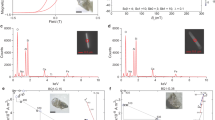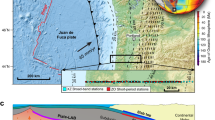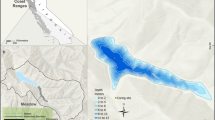Abstract
During the chemical weathering of silicate minerals, atmospheric carbon dioxide is incorporated into carbonate minerals and buried. As the rate of silicate weathering is thought to increase in response to increasing atmospheric CO2 concentrations, this represents an important negative feedback mechanism1. Quaternary records of weathering reflect a narrow range of pCO2 (180–300 p.p.m.v.)2; therefore, the extent of this feedback has been difficult to predict for increasing concentrations of atmospheric CO2. However, high CO2 levels of up to 1,125 p.p.m.v. have been suggested for the Early Eocene Climatic Optimum (52 to 50 million years ago)3,4,5. Here, we combine 40Ar/39Ar ages6 and the measured volumes of river-derived sediments and sodium-bearing evaporites to determine rates of physical erosion and chemical weathering in the Green River Basin, western United State of America, during the Early Eocene Climatic Optimum7. We find physical erosion rates of 420±79 t km2 yr−1 and chemical weathering rates of 62.5±21.9 t km2 yr−1. The calculated denudation rates of 175±30 m Myr−1 rival the highest documented non-glacial Quaternary rates for crystalline bedrock8. We suggest that elevated atmospheric CO2 levels during the Early Eocene epoch led to enhanced silicate dissolution rates9, and thus to increased production of loose rock material and higher rates of physical weathering and denudation.
This is a preview of subscription content, access via your institution
Access options
Subscribe to this journal
Receive 12 print issues and online access
$259.00 per year
only $21.58 per issue
Buy this article
- Purchase on Springer Link
- Instant access to full article PDF
Prices may be subject to local taxes which are calculated during checkout



Similar content being viewed by others
References
Suchet, P. A. & Probst, J. L. A global model for present-day atmospheric/soil CO2 consumption by chemical erosion of continental rocks (GEM-CO2). Tellus B 47, 273–280 (1995).
Petit, J. R. et al. Climate and atmospheric history of the past 420,000 years from the Vostok ice core, Antarctica. Nature 399, 429–436 (1999).
Lowenstein, T. K. & Demicco, R. V. Elevated Eocene atmospheric CO2 and its subsequent decline. Science 313, 1928 (2007).
Zachos, J., Pagani, M., Sloan, L., Thomas, E. & Billups, K. Trends, rhythms, and aberrations in global climate 65 Ma to present. Science 292, 685–693 (2001).
Fletcher, B. J., Brentnall, S. J., Anderson, C. W., Berner, R. A. & Beerling, D. J. Atmospheric carbon dioxide linked with Mesozoic and early Cenozoic climate change. Nature Geosci. 1, 43–48 (2008).
Smith, M. E., Carroll, A. R. & Singer, B. S. Synoptic reconstruction of a major ancient lake system: Eocene Green River Formation, Western United States. Geol. Soc. Am. Bull. 120, 54–84 (2008).
Einsele, G. & Hinderer, M. Quantifying denudation and sediment-accumulation systems (open and closed lakes): Basic concepts and first results. Palaeogeogr. Palaeoclimatol. Palaeoecol. 140, 7–21 (1998).
Riebe, C. S., Kirchner, J. W. & Finkel, R. C. Erosional and climatic effects on long-term chemical weathering rates in granitic landscapes spanning diverse climate regimes. Earth Planet. Sci. Lett. 224, 547–562 (2004).
West, A. J., Galy, A. & Bickle, M. Tectonic and climatic controls on silicate weathering. Earth Planet. Sci. Lett. 235, 211–228 (2005).
Dickinson, W. R. et al. Paleogeographic and paleotectonic setting of Laramide sedimentary basins in the central Rocky Mountain region. Geol. Soc. Am. Bull. 100, 1023–1039 (1988).
Wiig, S. V., Grundy, W. D. & Dyni, J. R. Trona resources in the Green River Basin, southwest Wyoming. US Geological Survey Open-File Report OF 95-476 (1995).
Pietras, J. T. & Carroll, A. R. High-resolution stratigraphy of an underfilled lake basin: Wilkins Peak Member, Eocene Green River Formation, Wyoming, USA. J. Sedim. Res. 76, 1197–1214 (2006).
Bradley, W. H. The geology of the Green River Formation and associated Eocene rocks in southwestern Wyoming and adjacent parts of Colorado and Utah. US Geological Survey Professional Paper 496-A (1964).
Roehler, H. W. Description and correlation of Eocene rocks in stratigraphic reference sections for the Green River and Washakie Basins, southwest Wyoming. US Geological Survey Professional Paper 1506-D (1992).
Carroll, A. R., Chetel, L. M. & Smith, M. E. Feast to famine: Sediment supply control on Laramide basin fill. Geology 34, 197–200 (2006).
Cullers, R. L. The controls on the major- and trace-element evolution of shales, siltstones and sandstones of Ordovician to Tertiary age in the Wet Mountains region, Colorado, U.S.A. Chem. Geol. 123, 107–131 (1995).
Hansen, W. R. Geology of the Flaming Gorge area Utah-Colorado-Wyoming. US Geological Survey Professional Paper 490 (1965).
Kunk, M. J. et al. 40Ar/39Ar ages of late Cenozoic volcanic rocks within and around the Carbondale and Eagle collapse centers, Colorado; constraints on the timing of evaporite-related collapse and incision of the Colorado River. Geological Society of America Special Paper 366, 213–234 (2002).
Kelley, S. A. & Chapin, C. E. Denudation history and internal structure of the Front Range and Wet Mountains, Colorado, based on apatite-fission-track thermochronology. New Mexico Bureau of Geology and Mineral Resources Bulletin 160, 41–77 (2004).
Wilf, P. Late Paleocene-early Eocene climate changes in southwestern Wyoming: Paleobotanical analysis. Geol. Soc. Am. Bull. 112, 292–307 (2000).
Taylor, J. R. An Introduction to Error Analysis (Univ. Science Books, Mill Valley, 1982).
Mason, G. M. Mineralogic Aspects of Stratigraphy and Geochemistry of the Green River Formation, Wyoming. Thesis, Univ. of Wyoming, Laramie (1987).
Sueker, J. K., Clow, D. W., Ryan, J. N. & Jarrett, R. D. Effect of basin physical characteristics on solute fluxes in nine alpine/subalpine basins, Colorado, USA. Hydrol. Process. 15, 2759–2769 (2001).
Andrews, J. A. & Schlesinger, W. H. Soil CO2 dynamics, acidification, and chemical weathering in a temperate forest with experimental CO2 enrichment. Glob. Biogeochem. Cycles 15, 149–162 (2001).
Syvitski, J. P. M. & Milliman, J. D. Geology, geography, and humans battle for dominance over the delivery of fluvial sediment to the coastal ocean. J. Geol. 115, 1–19 (2007).
Kirchner, J. W. et al. Mountain erosion over 10 yr, 10 k.y., and 10 m.y. time scales. Geology 29, 591–594 (2001).
Dethier, D. P. & Lazarus, E. D. Geomorphic inferences from regolith thickness, chemical denudation and CRN erosion rates near the glacial limit, Boulder Creek catchment and vicinity, Colorado. Geomorphology 75, 384–399 (2006).
Summerfield, M. A. & Hulton, N. J. Natural controls of fluvial denudation rates in major world drainage basins. J. Geophys. Res. 99, 871–883 (1994).
Matmon, A. et al. Temporally and spatially uniform rates of erosion in the southern Appalachian Great Smoky Mountains. Geology 31, 155–158 (2003).
Roehler, H. W. Chart showing identification of oil-shale and trona beds and their geophysical log responses in the Union Pacific Railroad Company El Paso corehole no. 44-3, Eocene Green River Formation, southwest Wyoming. US Geological Survey Miscellaneous Field Studies Map MF-2188 (1991).
Acknowledgements
We thank B. S. Singer, J. R. Dyni, J. C. Knox, D. C. Kelly, B. Tikoff and J. P. Smoot for assistance or discussions, and appreciate the thoughtful review by R.S. Anderson. Financial support was provided by National Science Foundation grants EAR-0230123, EAR-0114055 and EAR-0516760, and the Bailey Distinguished Graduate Fellowship at the University of Wisconsin.
Author information
Authors and Affiliations
Corresponding author
Supplementary information
Supplementary Information
Supplementary tables S1-S3 and figure S1 (PDF 243 kb)
Rights and permissions
About this article
Cite this article
Elliot Smith, M., Carroll, A. & Mueller, E. Elevated weathering rates in the Rocky Mountains during the Early Eocene Climatic Optimum. Nature Geosci 1, 370–374 (2008). https://doi.org/10.1038/ngeo205
Received:
Accepted:
Published:
Issue Date:
DOI: https://doi.org/10.1038/ngeo205
This article is cited by
-
Peak Cenozoic warmth enabled deep-sea sand deposition
Scientific Reports (2023)
-
Hydrological control of river and seawater lithium isotopes
Nature Communications (2022)
-
Floodplain evolution during the early Paleogene within the Piceance Creek Basin, northwest Colorado, U.S.A
Journal of Sedimentary Environments (2022)



